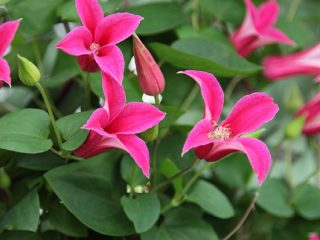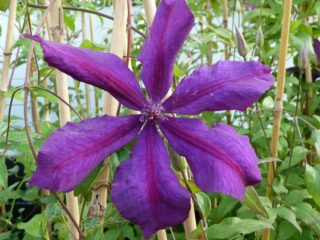Content
For quite a long time, many gardeners have believed that clematis is an exotic plant. Most people mistakenly assume that almost all species, including clematis Luther Burbank, are distinguished by a capricious disposition, but this judgment is erroneous. Even a beginner in this matter can acquire a beautiful liana in his own garden. Thanks to a wide range of products, everyone can choose the right clematis variety.
Description of clematis Luther Burbank
Clematis variety Luther Burbank is classified as a monochromatic species; as a rule, it is a classic that will never go out of style. With the help of this plant you can decorate not only flower beds, but also a gazebo, terrace, and balcony. Flowering is abundant and lasts for a long time. The advantage is the fact that the plant is practically not susceptible to diseases.
Judging by the photo, clematis Luther Burbank is a vigorous shrubby vine that can reach a height of 2.5 to 4 m, in some cases even up to 5 m. The shoots have a red-brown tint. As a rule, up to 10 shoots appear on each bush.
The leaf blade is quite complex, consisting of 3-5 leaves.The flowers open wide and are large in size. For example, the diameter of flowers can vary from 16 to 20 cm. There are only 6 sepals, they have a pointed ellipsoidal shape, with wavy edges. The color is purple-violet, which fades in summer, and becomes bright at low temperatures.
The anthers are quite large and can be yellow or light yellow. The flowering period lasts from June to September. From 9 to 12 flowers appear on each shoot.
A distinctive feature of clematis variety Luther Burbank is the fact that it is able to tolerate low temperatures down to -30°C. In addition, the plant is easy to care for and does not require drainage. Cultivation can be done both on fertile lands and on ordinary soil. Clematis grows well in sunny and shaded areas and loves regular watering.
Luther Burbank Clematis Pruning Team
When choosing planting material, it is recommended to pay attention not only to the attractive appearance, level of frost resistance and other characteristics, but also to the pruning group. Clematis Luther Burbank belongs to pruning group 3. As practice shows, plants of this group are excellent for growing in the central part of Russia. It is important to understand that with this group the plant must be trimmed completely.
Thanks to this procedure, more and more young shoots will appear on the vine every year, and the root system will develop significantly. In the year of planting, it is recommended to prune the bush completely, which will allow it to take root much better. Pruning is done in mid-autumn, before the first frost.
Planting and caring for clematis Luther Burbank
If you decide to plant clematis of the Luther Burbank variety, then special importance must be given to choosing a suitable location. Despite the fact that the liana can grow well in the shade, it is still a light-loving plant.
If there is not enough light, growth will be slow, as will development in general. Planting the crop in partial shade is only allowed in the southern regions, as the vines begin to suffer from constant overheating of the soil. When planting in groups, it is recommended to maintain a distance of at least 0.5 m.
During growth, watering must be plentiful. In addition, it is important to understand that excessive waterlogging of the soil at any time of the year is dangerous for plants. It is recommended to prepare the land for planting in advance. Clematis can grow in one place for 20 years.
Reproduction
Judging by the photo and description, clematis Luther Burbank can be propagated in several ways:
- dividing the bush – in this case, an adult liana, whose age is 5 years or older, is perfect. Using a sharp cutting object, the root system of the bush is divided into parts, after which each is rooted;
- layering – in the spring, it is necessary to press the shoots to the ground and secure them using staples. After a year, such cuttings can be separated from the mother bush;
- cuttings - the most popular method used for large-scale propagation of clematis.
If necessary, you can propagate plants at home yourself.
Diseases and pests
All varieties of clematis have a high level of resistance to disease, but they can also be attacked by pests. Most often, leaf plates and the root system are subject to attack - nematodes appear. If these pests are found, it is not recommended to plant vines in this place.
When a spider mite appears, you can notice how the color of the leaves changes to a yellow tint, cobwebs appear on them, and the buds dry out. Beet aphids suck all the nutrients from the leaves. In this case, it is necessary to treat the plant with insecticides.
In the fight against parasites, it is recommended to use garlic infusion. To do this, add 200 g of garlic to 10 liters of water.
Conclusion
Clematis Luther Burbank belongs to pruning group 3, as a result of which it is necessary every year to promptly remove excess shoots that interfere with the full growth of the vine. In addition, it is recommended to carefully inspect the bushes and, if necessary, remove dry and diseased vines. As practice shows, these procedures do not require much effort and time.










